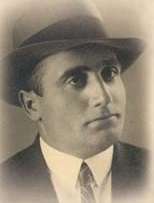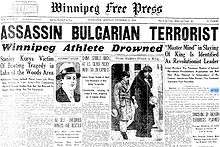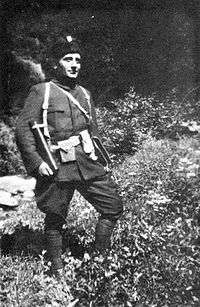Vlado Chernozemski
Vlado Chernozemski (Bulgarian/Macedonian: Владо Черноземски), born Velichko Dimitrov Kerin, Bulgarian: Величко Димитров Керин; 19 October 1897 – 9 October 1934), was a Bulgarian[1] revolutionary. Also known as "Vlado the Chauffeur", Chernozemski is considered a hero in Bulgaria today,[2] and in his time, in Croat circles and in the Macedonian Bulgarian diaspora.[3] His contribution to the independence of Macedonia has also won him a similar status in some ethnic Macedonian circles today, that proclaimed him an alleged "ethnic Macedonian", while in others he is regarded as a Bulgarian fascist.[4][5][6]
Vlado Chernozemski | |
|---|---|
 | |
| Born | Velichko Dimitrov Kerin 19 October 1897 |
| Died | 9 October 1934 (aged 36) |
| Nationality | Bulgarian |
| Occupation | Assassin, revolutionary |
| Years active | 1922–1934 |
| Organization | Internal Macedonian Revolutionary Organization |
| Known for | Assassinations of:
|
Chernozemski began his revolutionary activities in 1922, when he joined the Internal Macedonian Revolutionary Organization (IMRO). Soon after, he became an assassin for the IMRO. He killed two notable Bulgarian politicians, communist Dimo Hadzhidimov, and IMRO member Naum Tomalevski. Both times he was sentenced to death, but he escaped from his first imprisonment and was released from the second. After his release in 1932, he became an instructor for the Ustaše. He trained a group of three Ustaše to assassinate Alexander of Yugoslavia, but eventually killed Alexander himself on 9 October 1934 in Marseille. He was then beaten by French police and spectators, and died the same day. French Foreign Minister Louis Barthou was also killed by a stray bullet fired by French police during the scuffle following the attack.[7]
For murdering King Alexander I, Chernozemski was posthumously declared the most dangerous terrorist in Europe.[8][9]
Early life
Velichko Dimitrov Kerin was born in the village of Kamenitsa, now part of the town Velingrad.[10] His father, Dimitar Kerin, and his mother, Risa Baltadzieva, were both local peasants.[11][12] He received primary education in his native village. His mother died when he was 14 years old and the young Kerin was induced to help his father feed the family along with his younger brother and two sisters. Chernozemski joined the military in Plovdiv. During World War I, he served in the engineer corps. After the war he worked as a driver and watchmaker. As a youngster, he was prone to drinking alcohol, but later reformed and became a vegetarian. He married in 1919. In 1923, his daughter Latinka was born. In 1925, he divorced and remarried. He lived in Sofia until 1932. According to a conspiracy theory promoted by himself,[13] he was born in a village called Patrick near Štip, that was burned down by the Serbian army during the Second Balkan War, and was never restored.[14] His mother and father were therefore living in Bulgaria as refugees.[15] He used different aliases and pseudonyms such as Vlado Georgiev Chernozemski, Peter Kelemen, Vlado the Chauffeur, Rudolph Suk, Vladimir Dimitrov Vladimirov etc.[16] Even his second wife didn't know his real name, or anything about his past.[17] There are no records of him in Bulgaria beyond 1932, but he was re-identified in 1934, after his death in France.[18]
Revolutionary activity
IMRO
A legend describing Chernozemski as Vlado the Driver (Bulgarian: Владо Шофьора) appeared in Macedonia, since he worked for a company in Dupnitsa as a driver for a short time. In the early 1920s, he moved to Bansko, when the Internal Macedonian Revolutionary Organization (IMRO) was founded by Todor Alexandrov. Chernozemski joined the IMRO in 1922 in the unit Voivode Ivan Barlyo. From 1923 to 1924, he was a member of Trayan Lakavishki's cheta. Chernozemski also entered the region of Vardar Macedonia with IMRO bands and participated in more than 15 skirmishes with Yugoslav police.[19] He soon became one of the best marksmen in the organization,[19] known for his courage, sangfroid and discipline.
Assassin of the IMRO
In 1925 Ivan Mihailov became the new leader of the IMRO. In this period the organization took actions against the former left-wing activists, assassinating several of them. Mihailov assigned Chernozemski to assassinate MP Dimo Hadzhidimov, a member of the Communist Party of Bulgaria and former IMRO member. Chernozemski was arrested and sentenced to death by hanging for Hadzhidimov's assassination, but his execution was never carried out. In 1925, Chernozemski escaped from a police escort.
In 1927, Chernozemski proposed to the IMRO Central Committee to enter the main conference building of the League of Nations in Paris and detonate grenades attached to his person, in order to attract the attention of the world and generate publicity over the question of the Bulgarians in Macedonia, but his proposal was rejected.[19] In 1929, the leadership of the IMRO called on Ante Pavelić and the Ustaše for cooperation.
In 1930, Chernozemski, following an order by Mihailov, assassinated another member of the IMRO, Naum Tomalevski, and his bodyguard. Tomalevski had been a prominent member of the IMRO. For the second time, Chernozemski was sentenced to death, but he was pardoned in 1932.
Killing of King Alexander

After his release from the prison, Chernozemski disappeared. He moved to Italy, where he became an instructor for the Ustaše in a camp in Borgotaro.[20] He was then transferred to the Ustaše camp in Janka-Puszta, near Nagykanizsa in Hungary. The main purpose of this camp was planning for the assassination of King Alexander I. Chernozemski was the instructor of the group of three Ustašas: Mijo Kralj, Zvonimir Pospišil, and Milan Rajic, who were preparing to assassinate the king. On September 29, the four terrorists arrived in Paris, and on October 6 they split into two groups. Chernozemski and Kralj moved to Marseille, where the king was expected to arrive on October 9, and Pospišil, and Milan Rajic, moved to Versailles where they planned a second attack in case of failure of the first one. On 9 October 1934, Chernozemski carried out the murder, after concluding that the other members of the group were unprepared psychologically.[21]
As King Alexander's motorcade drove at a few miles per hour down a Marseille street in front of an adoring crowd, Chernozemski was able to emerge from the crowd, approach the king's car and leap onto its running board while concealing his Mauser C96 automatic pistol in a bouquet of flowers and chanting "Vive le roi" ("long live the king"). He shot Alexander repeatedly, hitting him twice, once in the abdomen and the other in the heart; King Alexander died within minutes. The chauffeur—who tried to push Chernozemski off the car—and Alexander's companion in the car, French Foreign Minister Louis Barthou, were also shot. Chernozemski killed the chauffeur, apparently unintentionally. A police officer fired at Chernozemski but missed and fatally wounded Barthou.[22] The chauffeur died almost immediately, with his foot pressed on the brake of the car, providing the opportunity for a photographer outside the car to photograph most of the grisly affair. Barthou might have survived, but did not, apparently because of inadequate medical attention.
After shooting a policeman who tried to seize him and inadvertently killing two bystanders, Chernozemski then futilely attempted to flee the scene but was struck by a slash from an escorting cavalryman's sabre, stunning him. He then received a non-mortal bullet wound in the head from a nearby police officer, and was fatally beaten by the enraged crowd while the police stood back and watched. Chernozemski was then brought in for interrogation. Since the assassin was in critical condition, he was unable to say anything and succumbed to his injuries later that evening, 10 days before his 37th birthday. The French police were unable to identify him; they could only register his tattoo, a skull with crossbones and a sign reading "V.M.R.O." (Bulgarian initials standing for Internal Macedonian Revolutionary Organization). He was buried in an unmarked grave in the Marseille cemeteries with only two detectives and the gravediggers present at the funeral. A Yugoslav journalist who saw the tattoo told the press it was the symbol of the IMRO. In the night of October 10, the French police arrested in Paris the Ustaša terrorists Zvonimir Pospišil and Milan Raijc. Five days later Mijo Kralj was arrested, who admitted everything. As a result, an exhumation was organized and fingerprints were sent from Paris to Sofia and Belgrade. On 17 October it was officially announced from Bulgarian police that the killer was Vlado Chernozemski.
Gallery
 Chernozemski in Ustaše uniform in 1934.
Chernozemski in Ustaše uniform in 1934. Memorial stone of Chernozemski in Kamenitsa, Bulgaria.
Memorial stone of Chernozemski in Kamenitsa, Bulgaria. The central street in Kamenitsa - „Владо Черноземски“.
The central street in Kamenitsa - „Владо Черноземски“. Automatic pistol used by Chernozemski to assassinate Alexander of Yugoslavia.
Automatic pistol used by Chernozemski to assassinate Alexander of Yugoslavia. Chernozemski's tattoo, depicting the abbreviature of the IMRO in Bulgarian.
Chernozemski's tattoo, depicting the abbreviature of the IMRO in Bulgarian.
| Wikimedia Commons has media related to Vlado Chernozemski. |
Footnotes
-
- Istoricheski pregled, Books 1-6, Bŭlgarsko istorichesko druzhestvo, Institut za istoria (Bŭlgarska akademia na naukite), 1987, str. 49.
- Велинград - online, публикувано на 12 октомври 2010 г. В памет на Владо Черноземски.
- Атентатът в Марсилия, Владо Черноземски. Живот,отдаден на Македония, Митре Стаменов, (Издание на ВМРО-СМД, София, 1993)
- Request of the Yugoslav government under article 11, paragraph 2, of the Covenant: Communication from the Hungarian government, Hungary - Yugoslavia, League of Nations, Tibor Eckhardt, Publisher League of Nations, 1934, p. 8.
- Stefan Troebst,"Historical Politics and Historical “Masterpieces” in Macedonia before and after 1991 Archived 2004-01-10 at the Wayback Machine", New Balkan Politics, Issue 6, 2003: "... the suicide-assassin from VMRO, Vlado Cernozemski, who, on orders from Mihajlov and his ethno-national VMRO, which was defined as Bulgarian, killed the Yugoslav king Alexander I Karadzordzevic and the French Minister of Foreign Affairs Louis Bareau in Marseilles in 1934."
- The national question in Yugoslavia: origins, history, politics, Cornell Paperbacks: Slavic studies, history, political science, Ivo Banac, Cornell University Press, 1988, ISBN 0-8014-9493-1, p. 326.
- Crown of thorns, Author Stéphane Groueff, Publisher Madison Books, 1987, p. 224.
- Balkan Firebrand - The Autobiography of a Rebel Soldier and Statesman, Todorov Kosta, READ BOOKS, 2007, ISBN 1-4067-5375-0, p. 267.
- Violette Nozière: a story of murder in 1930s Paris, Author Sarah C. Maza, Publisher University of California Press, 2011, ISBN 0-520-26070-8, p. 230.
- Shadows on the Mountain: The Allies, the Resistance, and the Rivalries That Doomed WWII Yugoslavia, Marcia Kurapovna, John Wiley and Sons, 2009, ISBN 0-470-08456-1, p. 157.
- Yugoslavia's ethnic nightmare: the inside story of Europe's unfolding ordeal, Jasminka Udovički, James Ridgeway, Lawrence Hill Books, 1995, ISBN 1-55652-215-0, p. 34.
- Contested Ethnic Identity: The Case of Macedonian Immigrants in Toronto, 1900-1996, Nationalisms Across the Globe, Author Chris Kostov, Publisher Peter Lang, 2010 , SBN 3034301960, p.139.
- Burn this house: the making and unmaking of Yugoslavia, Jasminka Udovički, James Ridgeway, Duke University Press, 2000, ISBN 0-8223-2590-X, p. 35.
- Izvestia na Natsionalnia istoricheski muzeĭ, Tomove 16–19, Natsionalen istoricheski muzeĭ, Izdatelstvo Nauka i izkustvo, 2006, str. 129.
- Crown of Thorns: The Reign of King Boris III of Bulgaria, 1918-1943, Stephane Groueff, Rowman & Littlefield, 1998, ISBN 1568331142, p. 224.
- Утрински весник, 02.03.2007, Виктор Цветаноски, Черноземски го уби кралот, но и многу Македонци.
- Виолета Ачкоска и Никола Жежов, "Предавствата и атентатите во македонската историја". Издателство Макавеј, Скопје, 2003, стр. 221.
- Весник Глобус, 16.10.2012, Коj не го затвора досието на Владо Чернозамски? Льубомир Костовски.
- de Launay, Jacques (1974). Les grandes controverses de l'histoire contemporaine 1914-1945. Edito-Service Histoire Secrete de Notre Temps. p. 568.
- Гаджев, Иван (2003). История на българската емиграция в Северна Америка: поглед отвърте (in Bulgarian). Илия Т. Гаджев. p. 259.
- България 20-ти век (in Bulgarian). Илия Т. Гаджев. 2000. p. 1127.
-
- Иван Габеров, Нейко Ненчев, Съвременна българска енциклопедия, том 1, Издателство Елпис, 1993, p. 516.
- Historical Dictionary of the Republic of Macedonia, Dimitar Bechev, Scarecrow Press, 2009, ISBN 0810862956, p.40.
- Георги Марков и колектив, Алманах на българските национални движения след 1878 г. Академично издателство "Марин Дринов", Българска академия на науките, 2005, София, ISBN 9543220441, pp. 372-373.
- Билярски, Цочо. Иван Михайлов в обектива на полиция, дипломация, разузнаване и преса. Университетско издателство Св. Климент Охридски. 2006, ISBN 978-954-9384-07-9, p. 198.
- Branislav Gligorijević, Kralj Aleksandar Karađorđević: U evropskoj politici, Biblioteka Jazon, Zavod za udžbenike i nastavna sredstva, 2002, p. 286.
- Request by the Yugoslav Government Under Article 11, Paragraph 2, of the Covenant, C. 518. M. 234. 1934. VII. Series of League of Nations. p. 8.
- Les Shawр, Trial by slander: a background to the Independent State of Croatia, and an account of the Anti-Croatian Campaign in Australia, Harp Books, 1973, p. 54.
- François Broche, Assassinat de Alexandre Ier et Louis Barthou: Marseille, le 9 octobre 1934, Volume 3 of Crimes politiques, Balland, 1977, ISBN 2715801130, p. 56.
- Roger Colombani, Jean René Laplayne, La Mort d'un roi: la vérité sur l'assassinat d'Alexandre de Yougoslavie, Histoire du XXe siècle, Albin Michel, 1971, p. 37.
- Петър Япов Никола Гешев, който не беше само полицай, Изток-Запад, 2002, ISBN 9544110844, p. 100.
- According to birth certificate No 74 of 1897, issued by the Kamenitsa municipality Velichko Dimitrov Kerin was born in the village of Kamenitsa on October 19, 1897. He was baptized on October 26, 1897 in the church in the village of Kamenitsa and it is recorded in the church registry under No. 77 of 1897. His godfather was Trendafil Zltanov. His father Dimitar Velichkov Kerin was born in the village of Kamenitsa in 1873. His mother Risa Hristoskova Baltadzhieva is from the same village, born in 1875, died on 30 March 1911. For more information see: Митре Стаменов, Атентатът в Марсилия, Владо Черноземски. Живот, отдаден на Македония, (Издание на ВМРО-СМД, София, 1993), стр. 41; Билярски Цочо, Владо Черноземски и атентатът в Марсилия 1934 г., Сведения на Дирекция на полицията, Отдел политическа полиция за връзките на ВМРО с усташите и изпращането на Вл. Черноземски при д-р Анте Павелич. в-к "Труд”, 28 юни 1990 г., бр. 126., достъпно онлайн на "Сите българи заедно"; The document is kept in Bulgarian Central State Archive, file 370 K, inventory 6, archive unit 411, sheets 16-36. Copy. Machine typing.
- Петър Япов, Из дневниците на митрополит Андрей Велички. Марсилският атентат - 1934 г. Изток-Запад, 2002, ISBN 954411081X, p. 23.
- Istoricheski pregled, tom 43, broeve 1–6, Bŭlgarsko istorichesko druzhestvo, Institut za istoriia (Bŭlgarska akademiia na naukite) str. 49.
- Гаджев, Ив., Иван Михайлов: отвъд легендите, Университетско издателство "Св. Климент Охридски", 2007, p. 180.
- Christowe Stoyan (1935). Heroes and Assassins (in English), p. 219.
- Крум Благов, Петдесетте най-големи атентата в българската история: Класация на най-важните заговори, покушения, саботажи и отвличания до 2000-та година, Репортер, 2000, стр . 154-155.
- Георги Георгиев Марков, Камбаните бият сами: Насилие и политика в България 1919-1947, "Св. Георги Победоносец", 1994, стр. 108.
- Боян Драганов, Зад завесата на големите скандали, Ахат, 2008, ISBN 9549664015, стр.160.
- Билярски, Цочо (2006). Иван Михайлов в обектива на полиция, дипломация, разузнаване и преса (in Bulgarian). Издателство Св. Климент Охридски. p. 198. ISBN 978-954-9384-07-9.
- Марков, Георги (1994). Камбаните бият сами: Насилие и политика в България 1919-1947 (in Bulgarian). Георги Победоносец. p. 108.
- Rothschild, Joseph (1959). The Communist Party of Bulgaria; Origins and Development, 1883-1936. Columbia University Press. pp. 277–278.
- Michael Newton, Famous Assassinations in World History: An Encyclopedia, ABC-CLIO, 2014, ISBN 1610692861, p. 10.
External links
Notes
| a. | ^ Following the Liberation of Bulgaria in the Russo-Turkish War of 1877-78, Bulgaria re-established self-rule. Subject to the Congress of Berlin in 1878, Bulgaria was denied outright independence but achieved suzerain status as the Principality of Bulgaria, a vassal of the Ottoman Empire. Bulgaria achieved full independence in 1908 before becoming a kingdom. |